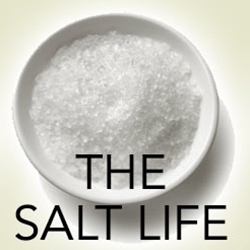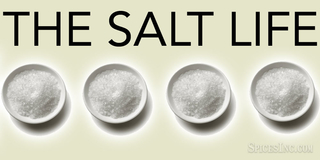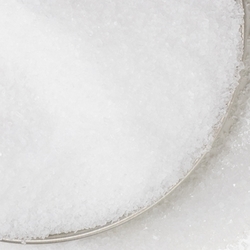
Today salt is an inexpensive food additive but just 200 years ago in the 1800s, it was an extremely expensive ingredient. Costing more than four times the amount of beef, salt was a necessary nutrient for living creatures, but also an incredible preservative used in many food storage processes all across the country. Now salt is everywhere, causing nearly as much commotion as sugar does here in the United States. We as a company see a growing number of concerned customers wondering about their salt intake every day. Through the course of over a decade of being in business, we have continued to develop more salt-free blends to help ease our customers' transitions into a lower sodium lifestyle.
Salt Basics
Whether your salt is Smoked Applewood or a Himalayan Pink Salt, there is very little difference between them chemically. Most salts are made up of at least 97.5% sodium chloride, with the final 2.5 percentage being made up of the other things that give color or flavor to the salt. They may also differ in texture, but that mostly has to do with how the salts are formed or harvested. Kosher salts are larger grain salts, perfect for taking a pinch and adding an even amount of salty flavor to the whole thing. Kosher salts are mostly mechanically pressed to get their long, flaky appearance and texture. Table salt is quite fine and is thus much saltier per pinch than kosher salt would be. Sea Salt is in between the two, with a more medium grain. Natural salts tend to fall on the sea salt part of the spectrum, because they have a medium grain when harvested directly from water.
Outside of the realm of size differences, salts also come from different places and are treated differently. For example, table salt comes from underground salt deposits and often contains the anti-caking agent calcium silicate. Sea salt and Kosher on the other hand have little to no processing minus the hydraulic pressing of kosher salt, which means that the minerals from the evaporated sea water is left in the salt.
Himalayan Pink Salt and Hawaiian Red Salt
Both salts have been making their rounds in health food circles and as buzzwords on morning television shows, with plenty of people claiming they are a healthier salt than table salt. The truth is, both are considered sea salts, and while they are a purer form of salt when compared to table salt, neither is significantly healthier than table salt. Their color comes from the trace minerals they contain, like calcium, copper, iron, magnesium, and potassium. Both can be used as a finishing salt, and in the Himalayas the pink salts have been used for hundreds of years to preserve fish.
At the end of the day, all salt is going to be more similar than not. Despite many claims that Himalayan Pink Salt or Hawaiian Red Salt is so much better for you, they are really like all the other types of salts and should only be used in moderation. They may have slightly different flavor profiles thanks to their trace minerals, but they are still a source of sodium. Their trace minerals don't exist in quantities that are nutritionally significant. Whatever salt you prefer to use is up to you, but don't reach for a colored salt thinking that you are getting some great nutritional benefit from it. You are not.
Low Sodium Diet
Visit any restaurant in the United States and it is easy to see that Americans love salt. The U.S Centers for Disease Control and Prevention, or the CDC, reports that nearly 70% of Americans consume double the amount of sodium recommended daily. Overconsumption of salt has been linked to a risk of higher blood pressure, which raises the risk for heart disease and stroke, the first and third leading causes of death in the United States. The main source of sodium in the United States is salt, so a lot of the dangers associated with eating a lot of the mineral have been linked to the ubiquitous, white shaker of salt.
The main source of sodium consumed by Americans comes from packaged and processed foods. This is the reason why it is so important to read food labels when you are shopping. Understanding serving sizes and sodium content per serving will help you make informed decisions about what foods you are going to buy. When cooking at home, choose as many fresh ingredients as possible. If you are eating canned vegetables, go for those with low sodium or no sodium added. When eating out, opt for low sodium options. Choose fresh fruits and vegetables and request that your food be prepared without salt where they can.
How Much Salt?
Here at Spices, Inc. we are constantly discussing how we can improve our site and these conversations almost always fall back on our recipes. We want to explore building tremendous flavors without compromising on maximum nutritional value, and this often includes coming up with new recipes that aren't so heavy on the salt. A lot of salt doesn't always equal a lot of flavor, and we are looking to break down that stereotype with our extremely flavorful salt-free blends and low sodium recipes. Currently, Americans each consume over 3,400mg of sodium per day! This is quite a bit more than the recommended 1,500mg to 2,300mg.
Americans' taste for salt may not be entirely their fault, however. Some scientists think that a love of salt may be influenced by genetics. Scientists discovered that certain variations in the TAS2R38 gene may make some people more susceptible to bitter tastes than those who lack that variation. The scientists found that people with this gene variation are more likely to enjoy salty foods, which they link to the fact that salt neutralizes bitter flavors in foods. However, this was only true in adults. In children, the gene was linked to a desire for more sucrose in the diet. There are also "supertasters," people who experience food with a huge amount of depth and vibrancy that regular or non-tasters don't understand. Scientists aren't certain why some people are supertasters, though it is widely believed that it probably has something to do with genetics as well. Supertasters often enjoy a large amount of salt despite being more sensitive to the saltiness, because of all the other things that salt does to the food. For example, canceling out bitterness applies here, but drawing the sweetness out of a caramel for would be another way that salt enhances the flavor of food.
As true with most other things, the amount of salt you like to eat is contingent on how much salt you already eat. If you start eating more salt, your body will expect and want more salt. If you adjust to a low sodium diet, your food preferences in general will shift to include more low sodium foods. This is exactly what happens with sugar consumption, as well. Cravings are heavily influenced by what our bodies are already used to. That's why people who enjoy a high salt diet and then cut back drastically find themselves desperate for a crunchy potato chip. If you are careful and scale back slowly, you are less likely to experience intense cravings.
What Constitutes a Low Sodium Recipe?
Typically, if a recipe claims to be "low sodium" it must have less than 500mg of sodium per serving. If you use a daily average of 1,900mg of salt, the number that falls directly in the middle of the recommended daily salt intake per adult in the United States, you can determine how much sodium a total meal should have. If you eating 5 meals a day, you will only want 375mg of sodium per meal. If you are having 3 meals a day, that number moves up to about 633mg of sodium per meal. What looks like a low sodium meal may be different between two people, depending on how often each individual eats. What they are eating also plays a role.
Reducing Your Sodium Intake
If you're someone who is regularly consuming 3,400mg of sodium a day and you are hoping to reduce your sodium intake, you should take small steps first and avoid a drastic diet change. Drastic changes are often disregarded just as quickly as they were made in the first place because they are so big a change, so it's important to pace yourself and make many small changes over an extended period. Allow your body and your taste buds to adjust over time. Eventually you may learn to genuinely love low sodium foods. Reduce to 3,200mg a day, and then after a week or two, work toward 3,000. Decrease your sodium levels every two weeks until you've hit around 1,900mg. If there are setbacks, don't beat yourself up about them. Simply move forward and continue to commit to the steps needed to consume less salt.
Be careful not to cut out too much salt, however. This can cause serious health problems as well. Did you know that the human body contains nearly a half pound of salt? Hyponatremia is a condition where the body doesn't have enough salt. It can cause dizziness, headaches, lethargy, confusion, and in some cases vomiting or seizures, which will quickly kill you if left untreated. Some athletes have been known to experience this after intense sporting events, but you can also experience it if you drink an excessive amount of water in a short period of time. This condition occurs when the amount of salt in your blood is lessened significantly. If you experience these symptoms and suspect that you may be hyponatremic, get to a hospital as soon as possible. Salt should be reintroduced to the body slowly and under supervision.
It goes without saying that moderation is key, but don't limit yourself to the point where you make yourself ill! Watching your salt intake, understanding where your love of salt comes from, and learning how to curb cravings through introducing low sodium foods slowly are all steps you can take toward more thoughtful eating habits.
Read More
When and How to Use Salt During Cooking
All About Spices
Salt Facts


